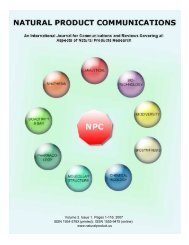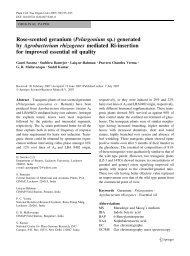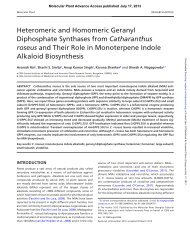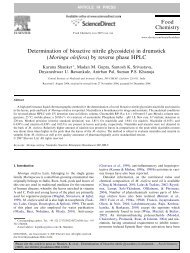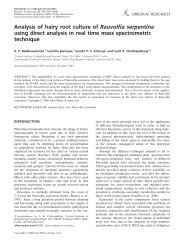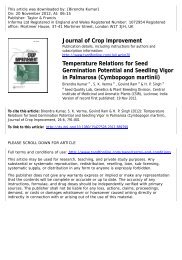Recent advances in plant hepatoprotectives - CIMAP Staff - Central ...
Recent advances in plant hepatoprotectives - CIMAP Staff - Central ...
Recent advances in plant hepatoprotectives - CIMAP Staff - Central ...
You also want an ePaper? Increase the reach of your titles
YUMPU automatically turns print PDFs into web optimized ePapers that Google loves.
764<br />
*<br />
NEGI ET AL.<br />
9. CONCLUSION<br />
Herbs have recently attracted attention as health beneficial food and as source materials for drug<br />
development. Herbal medic<strong>in</strong>es derived from <strong>plant</strong> extracts are be<strong>in</strong>g <strong>in</strong>creas<strong>in</strong>gly utilized to treat a<br />
wide variety of cl<strong>in</strong>ical diseases, with relatively little knowledge regard<strong>in</strong>g their modes of action.<br />
Dur<strong>in</strong>g the last few years, the use of herbal supplements was <strong>in</strong>creased from 2.5% to 12%. Natural<br />
compounds that reduce chemically activated enzymes, such as cytochrome P450 2E1, could be<br />
considered as good protective candidates aga<strong>in</strong>st chemically <strong>in</strong>duced toxicity for their role <strong>in</strong> the<br />
activation of many chemicals to comabat toxic and carc<strong>in</strong>ogenic agents. There are several herbal<br />
preparations available based on these leads <strong>in</strong> the market. Many a times, these herbal extracts or<br />
preparations are used as complementary and alternative medic<strong>in</strong>es (CAM) for liver diseases. Cl<strong>in</strong>ical<br />
trials to evaluate the hepatoprotective efficacy and toxicity of herbs are difficult due to heterogenous<br />
formulations and dosage, but these studies are possible <strong>in</strong> the case of pure compounds. Despite the<br />
tremendous <strong>advances</strong> made <strong>in</strong> medic<strong>in</strong>e, so far no effective hepatoprotective agent is available <strong>in</strong> the<br />
market. With the revolution of the natural sciences and evidence-based medic<strong>in</strong>e there is no doubt<br />
that herbal products conta<strong>in</strong> chemically def<strong>in</strong>ed components that can protect the liver from various<br />
<strong>in</strong>juries. Although additive effects may be lost, the active molecules must be isolated and tested<br />
through well designed experiments and f<strong>in</strong>ally <strong>in</strong> randomized, placebo-controlled studies to enable<br />
rational cl<strong>in</strong>ical use of the agents. Thus, biologically active molecules derived from herbal extracts<br />
may serve as suitable primary compounds for effective and targeted hepatoprotective drugs<br />
(Table IV).<br />
Table IV. Hepatoprotective Leads at a Glance<br />
S.No. Lead molecule Basic skeleton Mode of action Potent action<br />
aga<strong>in</strong>st<br />
1. Silymar<strong>in</strong> flavanolignoids antioxidant alcoholic liver<br />
diseases, acute and<br />
chronic viral<br />
hepatitis, tox<strong>in</strong><br />
<strong>in</strong>duced liver<br />
diseases.<br />
2. Andrographolide, diterpenic free radical scaveng<strong>in</strong>g paracetamol<br />
neoandrographolide lactones<br />
<strong>in</strong>duced liver<br />
damage,<br />
3. Curcum<strong>in</strong> phenolic antioxidant liver damage by<br />
alcohol and drugs<br />
4. Picroside,<br />
kutkoside<br />
irridoid<br />
glycosides<br />
free radical scaveng<strong>in</strong>g<br />
liver damage by<br />
drugs and other<br />
tox<strong>in</strong>s<br />
5. Phyllanth<strong>in</strong>,<br />
hypophyllanth<strong>in</strong><br />
lignans free radical scaveng<strong>in</strong>g chronic hepatitis B<br />
virus<br />
6. Glycyrrhiz<strong>in</strong> triterpenic<br />
glycoside<br />
antioxidant/anti<strong>in</strong>flammatory chronic hepatitis C<br />
ACKNOWLEDGMENTS<br />
The authors thank Dr. P.K. Chaudhuri for his critical suggestions to improve the manuscript.<br />
Medic<strong>in</strong>al Research Reviews DOI 10.1002/med




